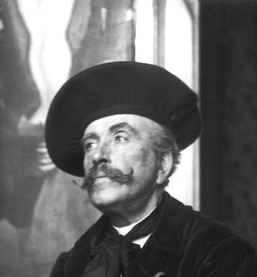 On this day in 1910, post-impressionist painter Henri Rousseau died in Paris at the age of 66. Born Henri Julien Félix Rousseau on May 21, 1844 in Laval, Mavenne. He was also known as Le Douanier (the customs officer), a humorous description of his occupation as a toll and tax collector. He started painting seriously in his early forties; by age 49, he retired from his job to work on his art full-time.
On this day in 1910, post-impressionist painter Henri Rousseau died in Paris at the age of 66. Born Henri Julien Félix Rousseau on May 21, 1844 in Laval, Mavenne. He was also known as Le Douanier (the customs officer), a humorous description of his occupation as a toll and tax collector. He started painting seriously in his early forties; by age 49, he retired from his job to work on his art full-time.
Ridiculed during his lifetime by critics, he came to be recognized as a self-taught genius whose works are of high artistic quality. Rousseau’s work exerted an extensive influence on several generations of avant-garde artists.
In 1868, he married Clémence Boitard, his landlord’s 15-year-old daughter, with whom he had six children (only one survived). In 1871, he was appointed as a collector of the octroi of Paris, collecting taxes on goods entering Paris. His wife died in 1888 and he married Josephine Noury in 1898.
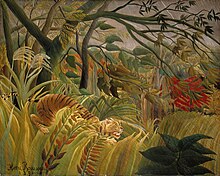
Tiger in a Tropical Storm (Surprised!) (1891) was the first of many jungle scenes for which Rousseau is best known.

The Dream (1910), MoMA
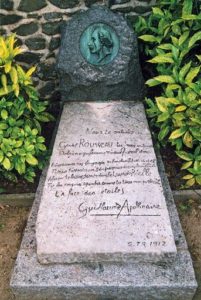
The Final Footprint
Cimetière parisien de Bagneux. Another notable footprint at Bagneux is that of Jules Laforgue. At his funeral, seven friends stood at his grave: the painters Paul Signac and Manuel Ortiz de Zárate, the artist couple Robert Delaunay and Sonia Terk, the sculptor Brâncuși, Rousseau’s landlord Armand Queval, and Guillaume Apollinaire who wrote the epitaph Brâncuși put on the tombstone:
We salute you Gentle Rousseau you can hear us.
Delaunay, his wife, Monsieur Queval and myself.
Let our luggage pass duty free through the gates of heaven.
We will bring you brushes paints and canvas.
That you may spend your sacred leisure in the
light and Truth of Painting.
As you once did my portrait facing the stars, lion and the gypsy.
Gallery

The Hungry Lion Throws Itself on the Antelope, 1905

in 1902
-
-

A Carnival Evening, 1886, Philadelphia Museum of Art, Philadelphia, PA
-
-
-

Self Portrait, 1890, National Gallery, Prague
-
-
-

Boy on the Rocks, 1895–97, National Gallery of Art, Washington, D.C.
-
-
-
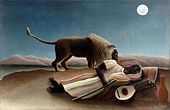
The Sleeping Gypsy, 1897, MoMA, New York
-
-
-

La tour Eiffel peinte par Henri Rousseau, 1898, Houston Museum of Fine Arts, Houston
-
-
-

Le Moulin (The Mill), c. 1896, Musée Maillol, Paris
-
-
-

Self-portrait of the Artist with a Lamp, 1903
-
-
-

Exotic Landscape, 1908, Private collection
-
-
-

Fight Between a Tiger and a Buffalo, 1908, Cleveland Museum of Art, Cleveland, Ohio
-
-
-

In a Tropical Forest Combat of a Tiger and a Buffalo, 1908-1909, Hermitage Museum, St. Petersburg
-
-
-

The Flamingoes, 1907, Private collection
-
-
-
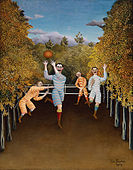
The Football Players, 1908, Solomon R. Guggenheim Museum, New York
-
-
-

Muse Inspiring the Poet (Portrait of Guillaume Apollinaire and Marie Laurencin), 1909, Kunstmuseum Basel, Switzerland
-
-
-
The Equatorial Jungle, 1909, National Gallery of Art, Washington, D.C.
-
-
-

The Snake Charmer, 1907, Musée d’Orsay, Paris
-
-
-

The Repast of the Lion, c.1907, Metropolitan Museum of Art, New York
-
-
-
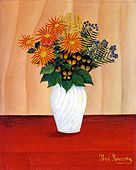
Bouquet of Flowers, 1910, Tate Gallery, London
-
-
#RIP #OTD in 1944 Jewish Russian writer, the first wife of painter Marc Chagall, subject of his paintings (Bella au col blanc (Bella with White Collar), Bouquet près de la fenêtre) Bella Rosenfeld died from a bacterial infection in Tupper Lake, New York aged 48. Westchester Hills Cemetery, Hastings-on-Hudson, New York
 On this day in 1973 writer, poet, philologist, and university professor, J.R.R. Tolkien died in Bournemouth, England at the age of 81. Born John Ronald Reuel Tolkien on 3 January 1892 in Bloemfontein in the Orange Free State (now Free State Province, part of South Africa). Best known as the author of the classic high fantasy works The Hobbit, The Lord of the Rings, and The Silmarillion. He was at one time a close friend of C. S. Lewis, both members of the informal literary discussion group known as the Inklings. Tolkien was appointed a Commander of the Order of the British Empire by Queen Elizabeth II on 28 March 1972. After his father’s death, Tolkien’s son Christopher published a series of works based on his father’s extensive notes and unpublished manuscripts, including The Silmarillion. These, together with The Hobbit and The Lord of the Rings form a connected body of tales, poems, fictional histories, invented languages, and literary essays about a fantasy world called Arda, and Middle-earth within it. Between 1951 and 1955, Tolkien applied the term legendarium to the larger part of these writings. While many other authors had published works of fantasy before Tolkien, the great success of The Hobbit and The Lord of the Rings led directly to a popular resurgence of the genre. This has caused Tolkien to be popularly identified as the “father” of modern fantasy literature or, more precisely, of high fantasy. Tolkien was married to Edith Mary Bratt (1916 – 1971 her death).
On this day in 1973 writer, poet, philologist, and university professor, J.R.R. Tolkien died in Bournemouth, England at the age of 81. Born John Ronald Reuel Tolkien on 3 January 1892 in Bloemfontein in the Orange Free State (now Free State Province, part of South Africa). Best known as the author of the classic high fantasy works The Hobbit, The Lord of the Rings, and The Silmarillion. He was at one time a close friend of C. S. Lewis, both members of the informal literary discussion group known as the Inklings. Tolkien was appointed a Commander of the Order of the British Empire by Queen Elizabeth II on 28 March 1972. After his father’s death, Tolkien’s son Christopher published a series of works based on his father’s extensive notes and unpublished manuscripts, including The Silmarillion. These, together with The Hobbit and The Lord of the Rings form a connected body of tales, poems, fictional histories, invented languages, and literary essays about a fantasy world called Arda, and Middle-earth within it. Between 1951 and 1955, Tolkien applied the term legendarium to the larger part of these writings. While many other authors had published works of fantasy before Tolkien, the great success of The Hobbit and The Lord of the Rings led directly to a popular resurgence of the genre. This has caused Tolkien to be popularly identified as the “father” of modern fantasy literature or, more precisely, of high fantasy. Tolkien was married to Edith Mary Bratt (1916 – 1971 her death).
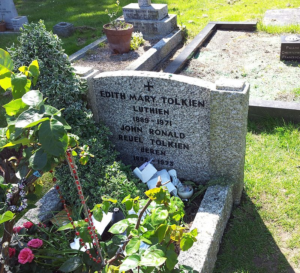 The Final Footprint – Tolkien is interred with his wife Edith in Wolvercote Cemetery, Oxford, England. Their graves are marked by an upright companion granite marker.
The Final Footprint – Tolkien is interred with his wife Edith in Wolvercote Cemetery, Oxford, England. Their graves are marked by an upright companion granite marker.
Have you planned yours yet?
Follow TFF on twitter @RIPTFF


